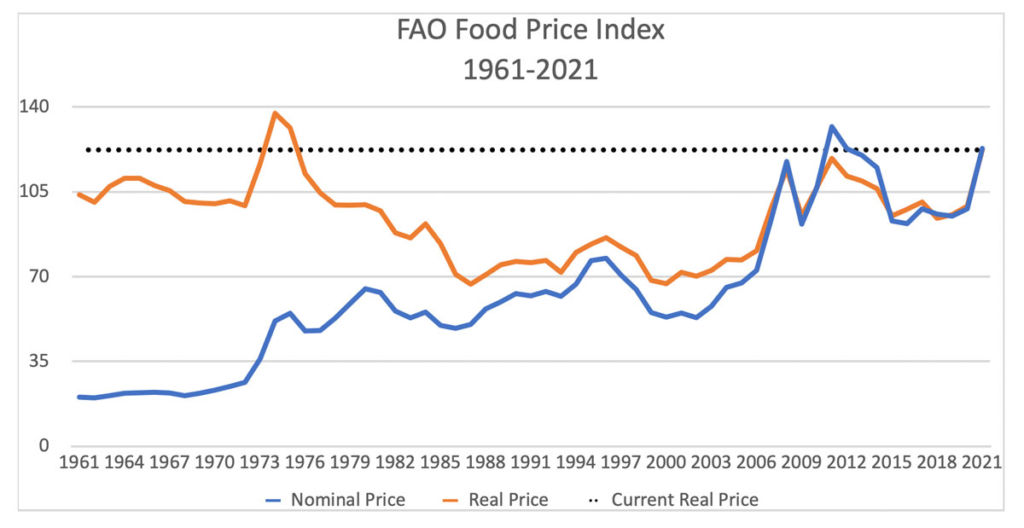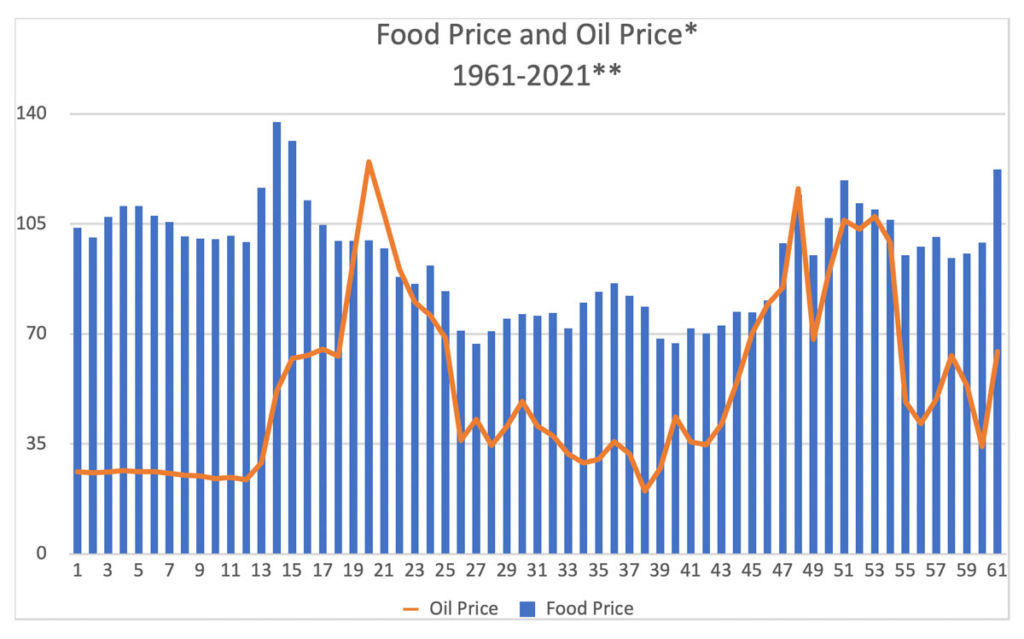In September 2021 world food prices reached a ten-year high. According to the United Nations Food and Agriculture Organization’s (FAO) Food Price Index, which tracks international prices of the most globally traded food commodities, prices averaged 130.0 points. This is the highest since September 2011 and a 32.8% year-on-year increase. In fact, when prices are adjusted from nominal to real terms, they are higher now than almost any time since records began with the exception being the oil price crisis in the 1970s.
 Source: FAO – for nominal prices 2014-2016 = 100
Source: FAO – for nominal prices 2014-2016 = 100
Why is this important?
There is a demonstratable link between high food prices and civil unrest and political instability. In 2008 there were at least 60 food riots in 30 countries including India, Cote d’Ivoire, Egypt, Indonesia, and Uzbekistan. In 2011 there were food-related riots in at least 15 countries and the increased prices are considered to be one of the drivers of the “Arab Spring” which toppled governments across the Middle East and North Africa, triggering the ongoing conflicts in Libya and Syria. Many of the countries affected in 2008 and 2011 continue to rely on the global food system and therefore remain vulnerable to global food prices.
What caused previous food price increases?
There are multiple reasons why food prices increase but several common factors contributed to the previous spikes in 1972-4, 2007/8, and 2010-12.
In 1972, bad weather reduced food production by 33 million tons when an extra 24 million tons was needed to meet the needs of a rapidly rising population. The following year oil prices quadrupled, which significantly increased inflation and the costs of food production. Further bad weather in 1974 resulted in poor crop yields for a third consecutive year. World cereal reserves reached a 22-year low, equal to sufficient supplies for about 26 days, compared with 95 days in 1961. At the same time, the United States banned the exportation of 10 million tons of grain because of domestic price rise fears, further constraining food supply. Prices then remained consistently high up until the early 1980s.
 Source: FAO, inflationdata.com
Source: FAO, inflationdata.com
*Annual average oil price adjusted for inflation from Bureau of Labor Statistics Consumer Price Index
**Prices as of September 2021
In 2007/8 there were some similarities with the 1970s. High oil prices had a direct impact on the costs of agricultural production and prices. There was an increased demand for food from countries experiencing rapid economic growth such as China and India, and increased demand to support biofuel production. Lastly, droughts in major food exporting countries reduced supply, leading to the lowest cereal stock levels for more than 30 years.
In 2010-12 oil prices once again spiked alongside the continued high demand for biofuel production and food. Weather-related disasters and wildfires in 2010, 2011, and 2012 diminished crop yields leading to restrictions on exports from major producers such as Russia and China further contributing to increased prices.
Why are food prices high now?
The factors contributing to the previous spikes in food prices are again all occurring to some extent. Oil prices have increased because of the high demand caused by the recovery in economic activity after the shutdowns related to the COVID-19 pandemic. The opening of economies has also increased demand for all commodities including food. This is putting supply chains under severe pressure and pushing up inflation. Additionally, the FAO reports that while cereal production is high, prolonged droughts and other adverse weather conditions in some of the major producing countries have impacted crop yields. Production is now forecast to be below the projected demand for 2021/22. This will reduce global inventories, which have been decreasing since 2017, and although supplies remain adequate prices will continue to be high.
What happens next/what to watch for
The FAO currently has food price warnings in place for ten countries including Argentina, Ethiopia, Nigeria, and Pakistan. Protests against high food prices have already taken place in Pakistan and Argentina, which on October 13 also reached an agreement with retailers to freeze the price of 1,247 food and household products. Other protests have taken place in Albania, Ecuador, and Cuba. In February 2021, seven regions of Sudan declared states of emergency following violent protests against food price rises. Other countries are also at risk of protests occurring. In August, it was reported that Egypt is considering reducing bread subsidies that have been in place for more than 40 years. If this occurs, then protests there are almost certain to take place.
Each previous spike has preceded an extended period of higher prices. The current situation does not appear to be different. In the coming months, the price of oil is forecast to stay high, the demand for food will remain high, supply chains will continue to be stretched, and climate change will likely increase the frequency of crop-damaging weather events. As we continue to deal with the economic fallout from the COVID-19 pandemic some countries will find themselves paying the same bill for lower volumes of food and struggling to provide adequate food security. Based on selected indicators such as food inflation, government debt, and budget deficit, as well as a precedent for similar protests taking place, countries at risk of anti-government protests over food prices include Colombia, Egypt, Ghana, Jordan, Kenya, Lebanon, Mozambique, and Pakistan. Other countries with a credible risk of protests include Argentina, Albania, Greece, Nigeria, and Uzbekistan.
Civil unrest will continue to be a significant security challenge in the coming months, affecting organizations either directly or through indirect consequences. Understanding triggers and signposts that inform about risk is essential to forecasting and assisting leadership in protecting and safeguarding institutions. Monitoring indicators such as food prices are one bellwether that can be added to an organization’s requirements.
Organizations should understand their exposure and regularly monitor and assess the issues that drive risk. AT-RISK International is prepared to help fulfill intelligence requirements by identifying how complex global security issues can impact organizations.
For more information or to discuss your security and risk mitigation needs, please contact a member of the AT-RISK International team.





